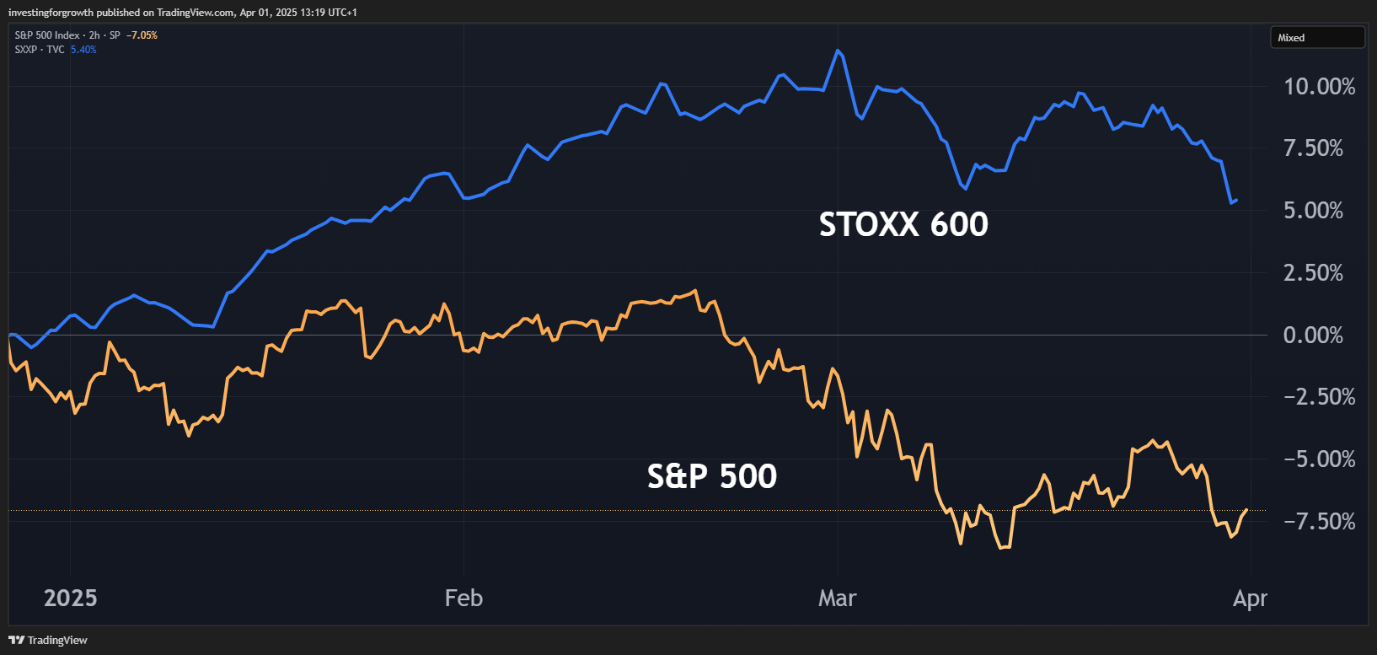Q1 Wall Street review: big losses and Liberation Day gossip
It was carnage during the first quarter, especially among American tech stocks, and the next wave of tariffs is a serious concern. City writer Graeme Evans rounds up the action in Q1 and possible outcomes for 2025.
1st April 2025 13:44
by Graeme Evans from interactive investor

Liberation Day looms with Tesla Inc (NASDAQ:TSLA) shares down 36% and NVIDIA Corp (NASDAQ:NVDA) off 19%, part of a $2.4 trillion loss in value for the Magnificent Seven stocks during Wall Street’s worst quarter since 2022.
- Learn with ii: ISA Investment Ideas | Top ISA Funds | Buy US Shares in UK ISA
The driving force of the S&P 500 index in 2024, the mega-cap grouping that also includes Apple Inc (NASDAQ:AAPL), Alphabet Inc Class A (NASDAQ:GOOGL), Amazon.com Inc (NASDAQ:AMZN), Microsoft Corp (NASDAQ:MSFT) and Meta Platforms Inc Class A (NASDAQ:META), ended the first three months of 2025 in bear market territory following a fall of more than 20% from December’s peak.
High valuations, stagflation fears (weak growth and high inflation) and the uncertainty stoked by Donald Trump’s tariffs and their potential impact on firms with global supply chains, have fuelled speculation that the period of “US techceptionalism” is coming to an end.
The recent vulnerability, which wasn’t helped by the launch of DeepSeek’s low-cost AI model, meant S&P 500 total returns fell by 5.6% in March and by 4.3% across the quarter.
- Trump dump: biggest rotation out of US stocks ever
- Tariffs: how to shield your portfolio from uncertainty and fund picks
- How investors can hedge against Trump’s trade wars
This marked the biggest quarterly performance gap to Europe’s benchmark STOXX 600 in a decade as a fiscal shift in Europe led to significantly higher defence spending.

Source: TradingView. Past performance is not a guide to future performance.
China’s high growth stocks also outperformed, as today’s first Deutsche Bank quarterly Tech Performance Review showed the Hang Seng Tech Index up 21% in its best start to the year since 2017. This was driven by gains of 56% for online retailer Alibaba Group Holding Ltd ADR (NYSE:BABA) and 27% for tech giant Tencent Holdings Ltd (SEHK:700).
Despite the recent weakness, Deutsche Bank expects the US tech sector to stabilise rather than sell off further.
It added: “The Magnificent Seven remain highly innovative and profitable companies, characterised by low cyclicality. They should, therefore, suffer less than the rest of the market in case of a US cyclical downturn.”
The first-quarter performance of Tesla was particularly dramatic, having seen its market value jump 93% in the wake of the US election from $800 billion to December’s $1.5 trillion.
It is now back around $800 billion due to materially weaker auto volumes, especially in Europe and, to some extent, negative perception from Elon Musk’s involvement in politics.
- Insider: more buying as SpaceX firm trades near 17-year high
- Europe’s stocks are crushing it. The question is whether that can last
- How to invest like the best: Warren Buffett
Nvidia stock rose 171% in 2024 but fell by 17% in a single day after DeepSeek’s low-cost AI model raised doubts about the sustainability of Nvidia’s market dominance.
The company’s earnings then showed the smallest revenue beat in two years, which was underwhelming for investors used to much bigger upside surprises. Both Tesla and Nvidia are also reliant on China for manufacturing or sales.
Their much cheaper valuations attracted strong interest among interactive investor customers during the quarter after the pair topped our list of most-bought stocks in the first quarter. Two-thirds of all trades were Buy orders in the period.
Among the other Magnificent Seven stocks, Deutsche Bank said Meta Platforms managed to outperform the S&P 500 for much of the quarter. It jumped 26% between January and February, but it eventually sank back to pre-January levels after a mid-March sell-off.
Alphabet fell 18% in the quarter, while Amazon reversed 13% and Apple and Microsoft both lost 11% of their value in the three months.
Does liberation mean losses?
The prospect of Trump’s Liberation Day reciprocal tariffs means volatility is likely to stay high given the difficulties of forecasting the impact on the economy and corporate profit margins.
The best guess of UBS Global Wealth Management is that tariffs will knock around two percentage points off 2025 S&P 500 earnings growth.
It now expects 6% earnings per share growth in 2025, prompting the bank to reduce its year-end target for the index to 6,400 from 6,600 previously.
- Sign up to our free newsletter for investment ideas, latest news and award-winning analysis
- 10 hottest ISA shares, funds and trusts: week ended 28 March 2025
UBS said: “This means that there is still meaningful upside by year-end. Despite weaker economic sentiment data, we believe the US economic and earnings backdrop remains healthy, and key structural drivers like AI demand are intact.”
The bank said tomorrow’s round of reciprocal and product tariffs will likely bring the effective tariff rate from today’s estimated 9% level into the low teens - at a minimum.
Even if tariffs move into the “highly aggressive” zone, UBS expects a return to an “aggressive” base case over its tactical investment horizon of three to six months as countries reach negotiated compromises or exemptions.
These articles are provided for information purposes only. Occasionally, an opinion about whether to buy or sell a specific investment may be provided by third parties. The content is not intended to be a personal recommendation to buy or sell any financial instrument or product, or to adopt any investment strategy as it is not provided based on an assessment of your investing knowledge and experience, your financial situation or your investment objectives. The value of your investments, and the income derived from them, may go down as well as up. You may not get back all the money that you invest. The investments referred to in this article may not be suitable for all investors, and if in doubt, an investor should seek advice from a qualified investment adviser.
Full performance can be found on the company or index summary page on the interactive investor website. Simply click on the company's or index name highlighted in the article.